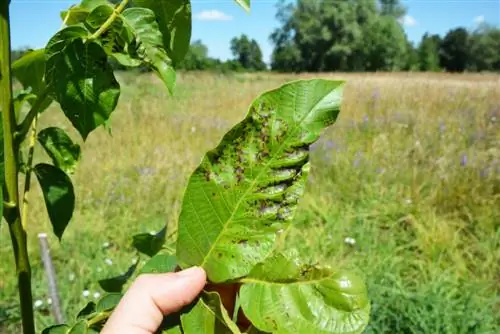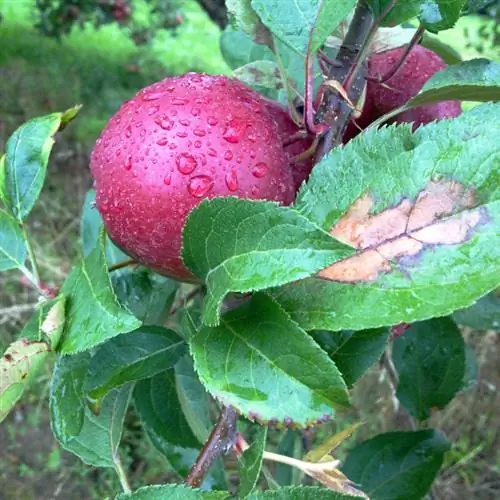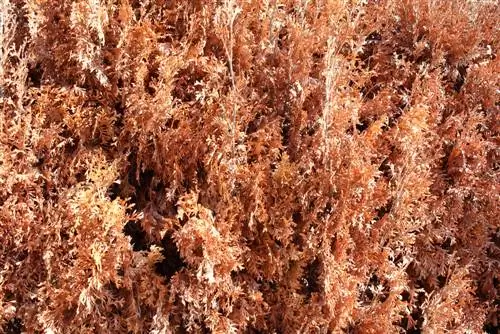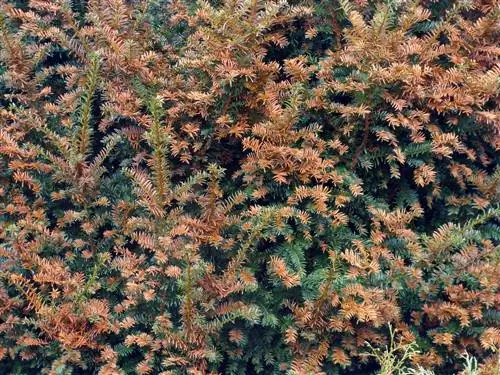- Author admin [email protected].
- Public 2023-12-16 16:46.
- Last modified 2025-01-23 11:21.
Although the walnut tree is one of the most robust tree species, it is not completely immune to diseases. In this guide you will learn about the most important problems and how you should deal with them.
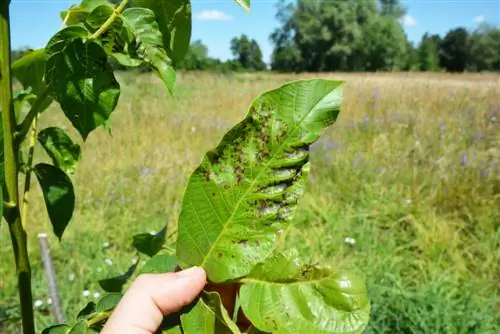
What diseases are common in walnut trees?
Walnut tree diseases are caused by fungi, bacteria and insects. Common problems include Marssonina leaf spot, bacterial walnut blight, pests such as the walnut fruit fly, and fungi that cause wood rot. Prevention and treatment include resistant varieties, proper tree pruning, insect control measures and tool hygiene.
Overview of the most common walnut tree diseases
Essentially can
- Fungi and bacteria as well as
- Insects (including larvae)
lead to diseases in the walnut tree.
Walnut diseases caused by fungi and bacteria
- Marssonina leaf spot
- Bacterial walnut burn
- Powdery mildew fungus
- Mushrooms of the genus Nectria
These four diseases occur on the trunk and bark and provoke the development of bark cancer.
- Hallimasch
- Sulphur Porling
- Shaggy Schillerporling
- Scaly Porling
- Ash tree sponge
These five fungal species are pests with a wide host range. They are responsible for wood rot.
Walnut tree diseases caused by insects
- Walnut felt gall mite
- Striped walnut louse
- Woolly scale insect
These three insects cause leaf damage. In young plants they can cause stunted growth.
- Willow borer larvae
- Blue Sieve Larvae
These two genera cause structural damage to the trunk of the walnut tree.
The maggots of the so-called walnut fruit fly also represent a typical problem.
Note: In addition, Phytophtora can damage and degenerate the roots of walnuts. Phytophtora refers to a genus of plant-damaging protists. These are microscopic creatures. Symptoms of Phytophtora disease: stunted shoots, yellowed leaves, thin crown.
Selected walnut tree diseases in portrait
We give space to Marssonina leaf spot (the most common walnut tree disease) in a separate article. Here we want to focus more intensively on bacterial walnut blight and the walnut fruit fly - two other diseases or pathogens that often occur.
Bacterial walnut burn
Bacterial blight is a walnut tree disease that can be found both in Germany and other European countries.
Rain and wind cause the bacteria to spread. Cracks, cracks and other wounds on the leaves and wood allow pests to penetrate - moisture acts as a catalyst.
The bark of the walnut tree is usually affected in autumn. From the following spring the plant shows signs of
- Bark cancer (wood growths) or
- Bark burn (dark bark, top layer peels off).
The leaves of the walnut reveal light spots. As a result, they turn brown. Finally the leaves fall off. Infected flowers look burnt.
How to fight (or prevent) bacterial walnut blight:
- plant resistant varieties
- avoid nitrogen-rich fertilizers
- Thinning the crown regularly
- only cut with disinfected tools
- Carry out tree pruning on dry days
- cut affected areas down to the he althy wood
- DO NOT dispose of affected plant parts in the compost
Walnut fruit fly
Walnut fruit flies are insects that lay their eggs in walnut fruits. Up to 30 larvae hatch inside and eat their way out through the pulp. Luckily, the actual walnuts remain intact and are still safe to eat.
Note: In commercial agriculture, infected nuts have to be cleaned extensively in order to be sellable.
How to combat (or prevent) walnut fruit flies:
- Pick up walnuts daily
- Lay a close-meshed net under the treetop from mid-June
The second measure prevents the maggots from hatching. In hot summers, fruit flies even die under the warm net.

